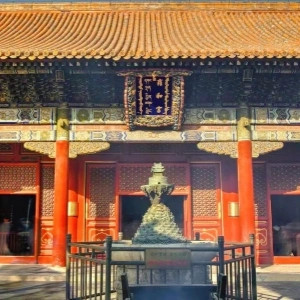Huangshan is located in the south of Anhui Province, spanning Shexian County, Xiuning County, Yixian County and Huangshan District, Huizhou District, covering a total area of about 1,200 square kilometers. Huangshan to legendary pines, picturesque rocks, sea of clouds, hot springs, winter snow “five” known in the world, these natural wonders are intertwined, constituting a picture of a moving landscape scroll. Huangshan has 88 peaks above 1,000 meters, of which “Lotus”, “Bright Top” and “Tendu” are the three main peaks, all over 1,800 meters above sea level, and the sea of clouds is tossing and turning as you climb the mountain. The sea of clouds and the mountains are beautiful.
Huangshan Scenic Area is divided into nine management areas: Hot Springs, Yungu, Yuping, Beihai, Songgu, Jiaoqiao, Fuxi, Yanghu, and Fugu, each of which has its own unique scenery and experience. Visitors can hike up the mountain and experience the charm of strange pines and rocks up close; they can also take the cable car and overlook the spectacular scenery of the tumbling sea of clouds. In addition, Huangshan has launched a variety of tourism activities, such as photography and sketching, self-driving camping, festivals and events, so that tourists can enjoy the beautiful scenery while participating in a rich and colorful cultural experience.
If you want to know more about Huangshan and itineraries, please contact us. Popular Tour Packages in Huangshan:
Huangshan climbing and hiking is a physically challenging and fun activity, the following is a detailed climbing and hiking strategy for your reference:
I. Pre-preparation
1. Choose the right season
Huangshan has four distinct seasons, but spring (March to May) and fall (September to November) is the best season for hiking. These two seasons have pleasant weather, beautiful scenery and relatively few tourists, so you can maximize your energy and enjoy the natural scenery.
2. Make a hiking plan
Before hiking Huangshan, it is important to make a scientific hiking plan. It is important to understand the topography of Huangshan and the distribution of the various attractions, and to plan the route according to your own physical ability and time schedule. There are several entrances to Huangshan, including South Gate, North Gate, Yungu Temple and West Gate, etc. Each entrance has its own unique route and characteristics.
3. Prepare equipment and articles
a. Wear: Wear comfortable and breathable sports equipment, such as hiking shoes, long pants and long-sleeved T-shirts. Meanwhile, prepare warm clothes accordingly to seasonal changes.
b. Equipment: hiking poles, gloves, knee pads, sunscreen, hats, sunglasses, raincoats, etc.
c. Items: water bottles, backpacks, food (such as chocolate, nuts and other high-calorie, easy-to-digest food), first aid kits, maps, compasses, etc.
II. Recommended Hiking Routes
1. Leisurely and unimpeded route (taking about 4-5 hours)
a. Uphill: Take the Yungu Ropeway to the top of the mountain.
b. Route: Yungu Ropeway → Shisun Peak → Shixin Peak → MengBi ShengHua → Monkey Viewing the Sea → Paiyun Pavilion → Guangming Peak → Ao Yu Peak → Hundred Steps to the Cloud Ladder → Lotus Peak → Yingkou Pine → Yuping Ropeway.
c. Downhill: Take the Yuping Ropeway to go down the mountain.
2. Hiking Small Loop (duration about 6-7 hours)
a. Uphill: Hike up the mountain from Yungu Temple.
b. Route: Yungu Temple → Xianren Fanzhuo → Ru Sheng Pavilion → Xianren Zhilu→ White Goose Ridge → Guangming Peak → AoYu Peak → Hundred Steps to the Cloud Stairs → Lotus Peak → Greeting Pine → Yuping Ropeway.
c. Downhill: Take the Yuping Ropeway down the mountain.
3. Hiking the Great Circuit (takes about 8-9 hours)
a. Uphill: Hike up the mountain from Yungu Temple.
b. Route: Yungu Temple → Xianren Fanzhuo → Ru Sheng Pavilion → Xianren Fanzhuo → White Goose Ridge → Guangming Peak → Feilai Stone → Paiyun Pavilion → Xihai Grand Canyon Ring → Xihai Grand Canyon Ring → Xihai Railway Cable Car → Hundred Steps to the Cloud Ladder → Lotus Peak → Welcome Pine → Yuping Ropeway.
c. Downhill: Take the Yuping Ropeway down the mountain.
4. Challenging Extreme Route (Duration about 10-11 hours)
a. Uphill: hike up from Yungu Temple.
b. Route: Yungu Temple → Xianren Fanzhuo → Ru Sheng Pavilion → Xianren Fanzhuo → White Goose Ridge → Stalagmite Peak → ShiXin Peak → MengBi ShengHua→Monkey Viewing the Sea→ PaiYun Pavilion → Guangming Ding → AoYu Peak → Hundred Steps to the Cloud Stairs → Lotus Peak → Greeting Pine → TianDu Peak→ Banshan Temple → Ciguangge.
c. Downhill: Hike down to Ciguangge.
Note: Tendu Peak is steeper and not suitable for the elderly, children and physically weak tourists.
III. Precautions
a. Safety first: During the climbing process, be sure to observe the regulations of the scenic area, wear non-slip shoes and do not act alone. Be extra careful when walking on steep sections and cliff edges.
b. Maintain physical strength: Reasonably distribute physical strength and avoid overwork. You can rest and replenish energy appropriately during the climbing process.
c. Environmental awareness: Maintain environmental hygiene and do not litter. Please bring back the garbage generated on the way up to the bottom of the mountain for disposal.
d. Weather Changes: The climate of Huangshan Mountain is changeable, please pay attention to the weather forecast and take appropriate protective measures. If you encounter bad weather, you should seek help and adjust your travel plan in time.
e. Accommodation and Catering: There are several lodging places and catering spots to choose from within the Huangshan Mountain Scenic Area. You can choose according to your needs and budget. It is recommended to book accommodation and catering in advance to avoid unnecessary trouble.
By preparing the above tips and observing the precautions, you will be able to safely and happily complete your climbing and hiking trip on Huangshan and leave unforgettable memories.
Related Posts
Create Your Customized Trip
Take about 2 minutes to fill the form to tell us how you like to travel, and get a reply within 1 working day.









